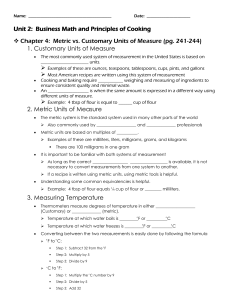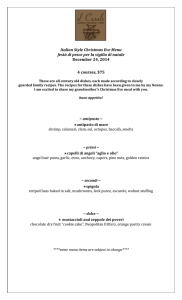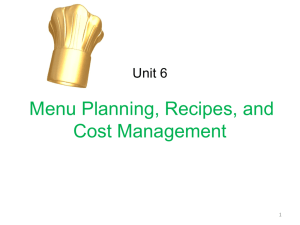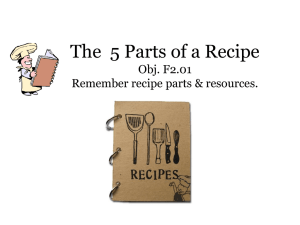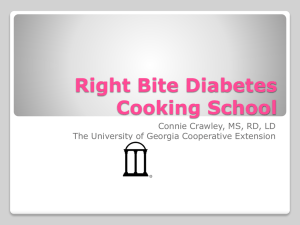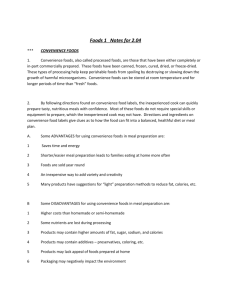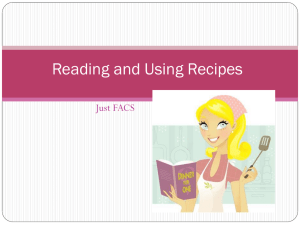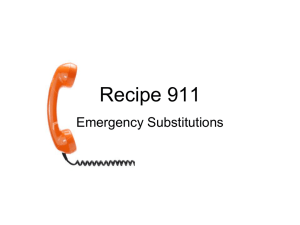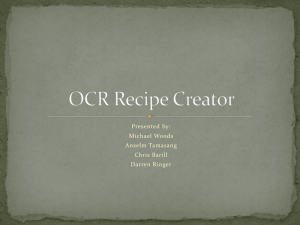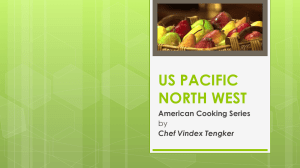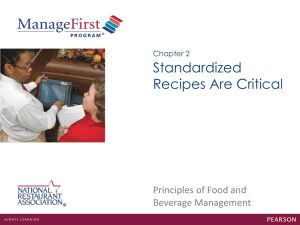Using Standardized Recipes
advertisement
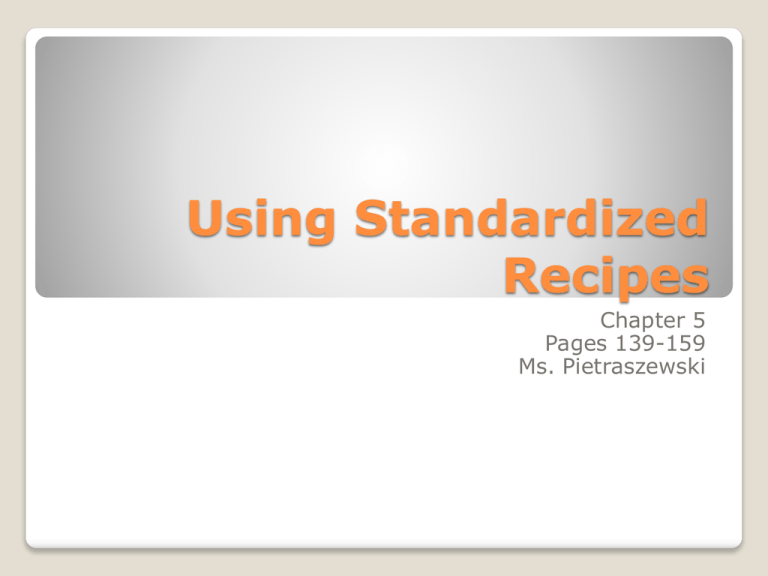
Using Standardized Recipes Chapter 5 Pages 139-159 Ms. Pietraszewski To learn how kitchens find recipes Understand the sections of a standardized recipe Reading recipes Understand measurement conventions and systems Understand measuring techniques Key Concepts Recipe: written record of the ingredients and preparation steps needed to make a particular dish. ◦ Can be based off of regional dishes, ethnic dishes, main ingredients, and part of the menu example: sushi, chicken, appetizer Recipes Cookbooks: in libraries and bookstores ◦ Categorized by dishes Periodicals: in newspapers and magazines ◦ Feature certain recipes Food Producers and Manufactures: encourage the use of their product Cooking Contests: publish winning recipes Internet: free recipes Common Sources of Recipes Standardized recipe: recipe designed to suit the needs of an individual kitchen. Purpose: ◦ ◦ ◦ ◦ Support consistent quantity and quality Encourage efficient purchasing and preparation Reduce costs by eliminating waste Enable the wait staff to answer questions honestly and accurately Standardized recipes Title: identifies the food item or dish Recipe Categories: able to group and organize recipes in a way that makes retrieval easier Yield: describes the measured output, expressed as one or more of the following: ◦ Total weight, total volume, or number of portions Ingredient List: listed in the order of which they are needed. ◦ Includes the name and amount of needed ingredients Sections of a Standardized Recipe Equipment: items needed for preparing, cooking, storing, holding, and serving an item ◦ Will be included in the basic kitchen procedures Method: includes the detailed steps required to make the dish. Service: Portion information, finishing and plating instructions and appropriate accompaniments (side dishes, sauces, etc.) Sections of a Standardized Recipe (cont.) PRN Method for Reading Recipes ◦ Preview: to get the picture ◦ Read: to focus carefully on the specifics of the recipe ◦ Note: write down any adjustments and plans for preparation Reading Recipes Yield: does this make enough or too much? Ingredients: Do you have all of them? Method: are you familiar with the method used? Timing: Do you need to preheat equipment? Serving and Holding: What do you do with the finished product? Questions to ask yourself There are one of three measuring conventions: Count: based on the number of whole items\ ◦ Good for measuring Standardized ingredients Ingredients that have been processed, graded or packaged according to established standards (eggs, shrimp, butter) Volume: measurement of the space occupied by a solid, liquid or gas ◦ Best for measuring liquids and small amounts of dry ingredients (spices, baking powder) Measurement Conversions and Systems Weight: measurement of its mass, or heaviness. ◦ Can be measured with greater accuracy than volume. Measurement Conversions and Systems (cont.) Metric System: standard international system of measurements. ◦ Volume: Liters (L) and milliliters (mL) ◦ Weight: miligrams (mg), gram (g), kilogram (kg) Measurement Systems U.S. System: ◦ Volume: teaspoon (tsp or t.), Tablespoon (tbsp or T), fluid ounces (fl. oz.), cup (c), pint (pt.), quart (qt.), gallon (gal or G) ◦ Weight: ounces (oz) and pound (lb) Measurement Systems (cont.) Dry Volume: overfill the measuring cup, and scrape off any excess ◦ Some recipes call for compressing (packing) Ex. Brown Sugar Liquid Volume: set the measuring cup or other clear container on a flat surface, and with your eyes level, fill to the mark. Measurement Techniques Weight: choose a scale that fits the size of your food ◦ When using a food scale, be sure to account for the tare weight The weight of the container holding the food. Measurement Techniques (cont.) 1 tablespoon Tbsp or T. 1 fluid ounce 1 cup fl. oz. c. 1 pint pt. 1 quart qt. 1 gallon gal or G ½ fl. Oz or 3 tsp 2 Tbsp or 6 tsp 16 Tbsp or 48 tsp or 8 oz 2 c., 32 Tbsp, 96 tsp or 16 fl. oz. 2 pt. , 4 c., 64 Tbsp, 192 tsp or 32 fl. oz 41 qt, 128 Tbsp, or 128 fl. oz Volume Measurements Measurement Technique Tools Dry Volume 1. Overfill container 2. Scrape off excess. Dry Measuring cups Measuring spoons Liquid Volume 1. Set container on flat surface. 2. Fill to correct mark 3. Inspect with eye level at mark. 4. Adjust as needed. Graduated containers, Liquid Measuring cups Measuring Spoons Weight 1. Set the tare. Scale, food trays or 2. Place food in containers to hold container on scale. food on scale 3. Read weight and add or remove food. Key Concepts ◦ Scale recipes up or down ◦ Scaling recipes by portion size ◦ Finding recipe yield based on available ingredients ◦ Using scaled recipes 5.2 Converting Recipes
